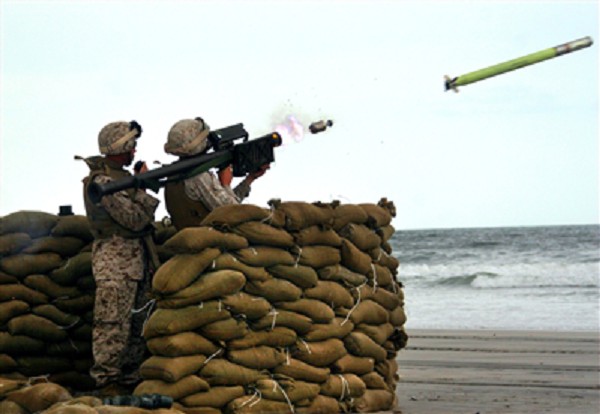
US, March 28, 2022 - The Stinger weapon system is a man-portable, shoulder-fired, infrared homing-guided/negative ultraviolet (UV) heat-seeking missile with modified proportional navigation. It requires no control from the gunner after firing. The system is equipped with an identification, friend or foe (IFF) subsystem, which aids the team in identifying friendly aircraft. Missile Round The missile round is composed of two major components: the fiberglass launch tube and the missile. Launch tube. The launch tube, which houses the missile, provides the main support for all other parts of the weapon round. Both ends of the launch tube are sealed with a breakable disk. The front infrared (IR) window is transparent to IR and UV radiation. Both the front and rear disks break when the missile is launched. The hinged sight assembly attached to the launch tube allows the gunner to sight the weapon, determine target range, super elevate, and hear the audible tones through the acquisition indicators. Missile. The Stinger missile consists of three sections: guidance, warhead, and propulsion sections.
- The guidance assembly processes target IR and UV radiation. It provides guidance commands for the missile during flight. The seeker tracks the IR/negative UV source automatically after the gyro is uncaged and during missile flight. The control assembly converts the guidance commands into movement of control surfaces that direct the flight of the missile.
- The warhead section consists of a fuse assembly and a quantity of explosives, housed within a cylindrical case. The fuse can detonate the warhead in three ways: by means of a low-impact switch, a hard target sensor, or by self-destructing. Should a target intercept not occur, a self-destruct circuit detonates the warhead.
- A separable launch motor and a dual thrust flight motor provide propulsion for the missile. The launch motor provides initial thrust that ejects the missile from the launch tube allowing the missile to coast to a safe distance from the gunner. The flight motor ignites and propels the missile to the target.
Weapon Round
A weapon round consists of a missile round fitted with a separable gripstock. The separable, reusable gripstock consists of operational controls, connectors, latch mechanism, and the IFF antenna assembly. Located on the gripstock assembly are the safety and actuator device, uncaging switch, firing trigger, IFF challenge switch, IFF interrogator connector, and battery/ coolant unit (BCU) receptacle. When the IFF antenna assembly is unfolded and the IFF interrogator is connected to the weapon, it is capable of interrogating aircraft and receiving coded replies. After a missile launch, the gripstock is removed from the launch tube.
Ready Round
A ready round consists of the weapon round and a battery coolant unit. When the battery coolant unit is inserted into the weapon round, it becomes a ready round. The battery coolant unit is a thermal battery that provides prelaunch power for the system and argon gas that cools the missile seeker for a maximum of 45 seconds (ready round). Once activated, the battery coolant unit must be removed within three minutes of activation to avoid damage to the gripstock due to excessive overheating. Once activated, the battery coolant unit is expended and removed from the gripstock.
Identification Friend or Foe Subsystem
The Stinger weapon system is equipped with an IFF subsystem to aid in the identification of aircraft. The IFF system is an electronic system that provides an automated means to identify aircraft as friend, possible friend, or unknown. It does not identify hostile aircraft.
Weapon and Missile Rounds
The Stinger missile is packaged as weapon round complete, weapon round partial, or missile round. A weapon round complete includes the missile round, gripstock, and varying numbers of BCUs packaged in a reusable aluminum container. A weapon round partial contains the missile round and varying numbers of BCUs packaged in a reusable aluminum container. The missile round contains the missile round and varying numbers of BCUs packaged in a fiberboard box within a wire-bound wooden container.
FIM-92D – Stinger-Reprogrammable Microprocessor (RMP). The RMP Stinger missile has additional improvements to the guidance system. These improvements enable the weapon to reject complex infrared countermeasures (IRCM), provide greater background discrimination than the basic Stinger, and have made the missile more responsive to steering commands. The addition of a reprogrammable module allows weapon updates to meet future threats without the need to modify missile hardware.
FIM-92E – Block I. The Block I Stinger missile has improved guidance system electronics, including a roll frequency sensor (ring laser gyro). This upgrade provides the missile with the capability of determining the up position before and during launch, allowing the missile guidance system to bias its flight to counteract gravitational forces. The Block I upgrade enhances missile performance when launched against targets in non-ideal scenarios, such as minimum target elevation angles and low target aspect angles in a clutter environment. FIM-92E Block I Stinger missiles only fly in the Block I mode and have full continental U.S. (CONUS) IRCM performance if they are launched with a Block I gripstock or platform launcher. Center for Army Lessons Learned.


